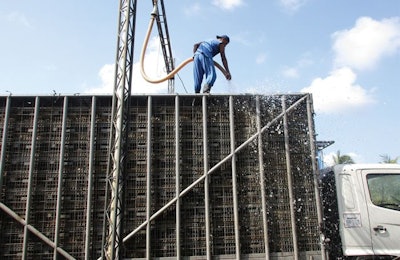
Processed chicken must be safe for consumers to eat and also have a good shelf life. To achieve both of these qualities, it must be produced in hygienic conditions, and microbial contamination kept to a minimum.
Various operations, starting with pre-slaughter, need to be closely monitored in real time to ensure that birds are kept clean. It is worth remembering that pre-slaughter and processing are highly linked, meaning that broilers must be as clean as possible on arrival at the processing plant if hygiene standards are to be maintained throughout processing.
Feed withdrawal
Feed is withdrawn 8-12 hours prior to slaughter. During withdrawal, feeders should be kept at their normal height until the capture team arrives. This allows the birds to eat any remaining feed and, once the feed is finished, to peck the feeders. Without the feeders in place, they will start to peck and ingest the litter and its microbial load.
The house temperature also needs to be closely monitored during feed withdrawal, especially in open houses.
When temperatures are very high, birds will eat less feed, affecting the consistency of fecal material and resulting in an increase in the emptying of the gastrointestinal tract. To counter this, feed withdrawal should be shortened during hot weather.
During cold periods, when temperatures fall below 16C, the gastrointestinal tract will be emptied more slowly and so feed withdrawal periods can be lengthened to counter this.
Capture and caging
The noise and rapid movements of the capture team will cause birds stress, leading to them defecating. This will result in the cloaca, and its surrounding skin and feathers, becoming contaminated with feces containing Escherichia coli, Salmonella and Campylobacter.
Once birds are caged and cages built into stacks, there is a strong likelihood that fecal matter will fall from birds in cages at the top of the stacks onto birds in the lower layers, making the risk of bacterial contamination of the birds in the lower cages very high.
Many companies operating in hot countries spray birds with water after they are loaded onto the trucks, prior to leaving the farm. This has the double benefit of not only removing fecal matter from them and the cages, but also of refreshing the birds prior to travel to the processing plant.
Transport and lairage
During transport, birds will again defecate, and so the process of contamination continues. As at the farm, some processing plants wash the birds with water and disinfectant once trucks have been weighed to remove the organic load and bacteria.
At the processing plant
Once the process of moving birds to the hanging area begins, their stress levels will again rise, peaking at removal from cages and hanging on the shackles. This will lead to defecation and contamination.
However, if this part of the plant has been properly equipped, for example, with low-level lighting and a properly installed and adjusted breast massager, the birds will return to a state of calm before reaching the stunner.
Nevertheless, there remains the risk of defecation if, immediately prior to stunning, a bird suffers pre-shock. Pre-shock also increases the risk of birds exiting the stunner still conscious and, should this occur, the likelihood of defecation increases at slaughter as a result of the intense pain experienced.
The slaughter operation itself also comes with high risk of microbial contamination. Where slaughter is carried out manually, knives must be kept in receptacles containing bactericides. If automatic, then blades must be sprayed with disinfectant to remove and kill as many bacteria as possible.
Scalding
Up to reaching the scalders, the amount of fecal matter on the birds may have been gradually increasing and, if not washed prior to entry, all of this bacteria-containing fecal matter will enter the scalders. Should any birds enter the scalder still alive, they will drown, and contaminated water will enter their bodies.
It is important to remember that scalding carries a risk of cross-contamination. To help prevent this, many plants use multiple scalding tanks where birds enter the tank at the opposite end to which the water enters, and this counter current can help to remove any fecal material.
Water temperature in the scalder is also crucial to maintaining the hygiene status, given that it can result in the reduction or growth of bacteria.
When a multi-tank system is used, the water temperature should increase sequentially, with the first tank kept under 50C, while successive tanks have higher temperatures. Studies have shown that if tank temperature should fall to 38-42C and there is Salmonella in bird excreta, it will rapidly multiply, given the ideal temperature for growth. Scalding tanks at this temperature range offer ideal growth conditions for bacteria and so the risk of carcass contamination increases. To prevent this, temperature range at scalding should be 53-56C.
Some plants use even higher temperatures, 58-60C, leading to a reduction in micro-organism contamination.
Plucking
Plucking operations can also lead to an increase in contamination if not properly managed. The pressure from plucking fingers can force Salmonella and Campylobacter, for example, into the birds’ open follicles, and the risk of this is higher where birds are not clean. Wing and tail feathers, which spring from the muscles, are not always easily removed. Because of this, more pressure is often be applied to the fingers, further raising the risk of bacteria entering the follicles.
Evisceration
Evisceration will reveal how well feed withdrawal was performed. If it has not been properly carried out, bacterial contamination will occur when the intestines break, or the caecum or crop, where there may be high levels of Salmonella or Campylobacter.
Because of this, it is very important that, prior to chilling, carcasses are washed, brushed and properly disinfected, to ensure that there is no organic residue either internally or externally.

Prior to chilling, carcasses should be washed and brushed to remove any remaining contamination. | Eduardo Cervantes Lopez

















